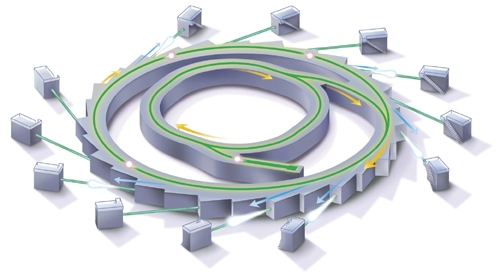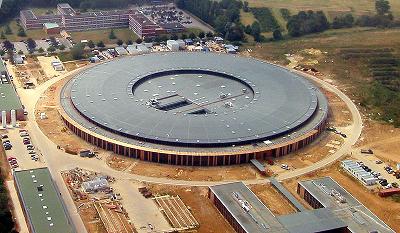The path of particles in a synchrotron follows a beam tube- a vacuum tube along which the various other components of the synchrotron are situated. This tube may be in a circular figure, but it may also be composed of straight segments with curved corners. This is typically the case as it provides areas where different experiments and operations can be performed with and on the beam without having to worry about turning the beam at the same time. These operations include cooling or colliding with other beams or stationary particles.
 17
17
|
| Here, a linear accelerator injects the inner synchrotron, which then injects the outer synchrotron. Various experiments are run off the perimeter using the accelerated beam. |
There is not much new material in terms of the physics behind a synchrotron as compared to the cyclotron; the differences lie simply in the specific configuration of the system used to accelerated particles and keep them going in a circle.
The particle beam in a synchrotron is turned by electromagnets that line the beam tube. In this way, the strength of the magnetic field can be increased to provide greater turning power as the particles are accelerated faster and faster, and as relativistic effects begin to become apparent. If an even greater magnetic field strength is required, superconducting magnets can be substituted for the electromagnets. The particles are accelerated in a way similar to in a linear accelerator: oscillating electric fields are aligned in series within the beam tube.

Since the magnetic field used to curve the synchrotron beam must keep changing as the particles go faster, it cannot support a constant beam of particles but must work with one pulse at a time. One advantage of the synchrotron, however, is that because it only requires a loop and doesn't cover an entire area, several synchrotrons can be joined together, either one within another or tangentially. Particles may also be injected into the synchrotron from a linear accelerator tangential to the synchrotron beam tube. By using a combination of accelerators linked in series, each of them accelerating a pulse of particles faster than the previous one, particles may be accelerated extremely close to the speed of light. This set up also allows for pulses to be sent much more closely one behind another. This means more interactions can be done with the beam in less time, which makes the system more efficient.